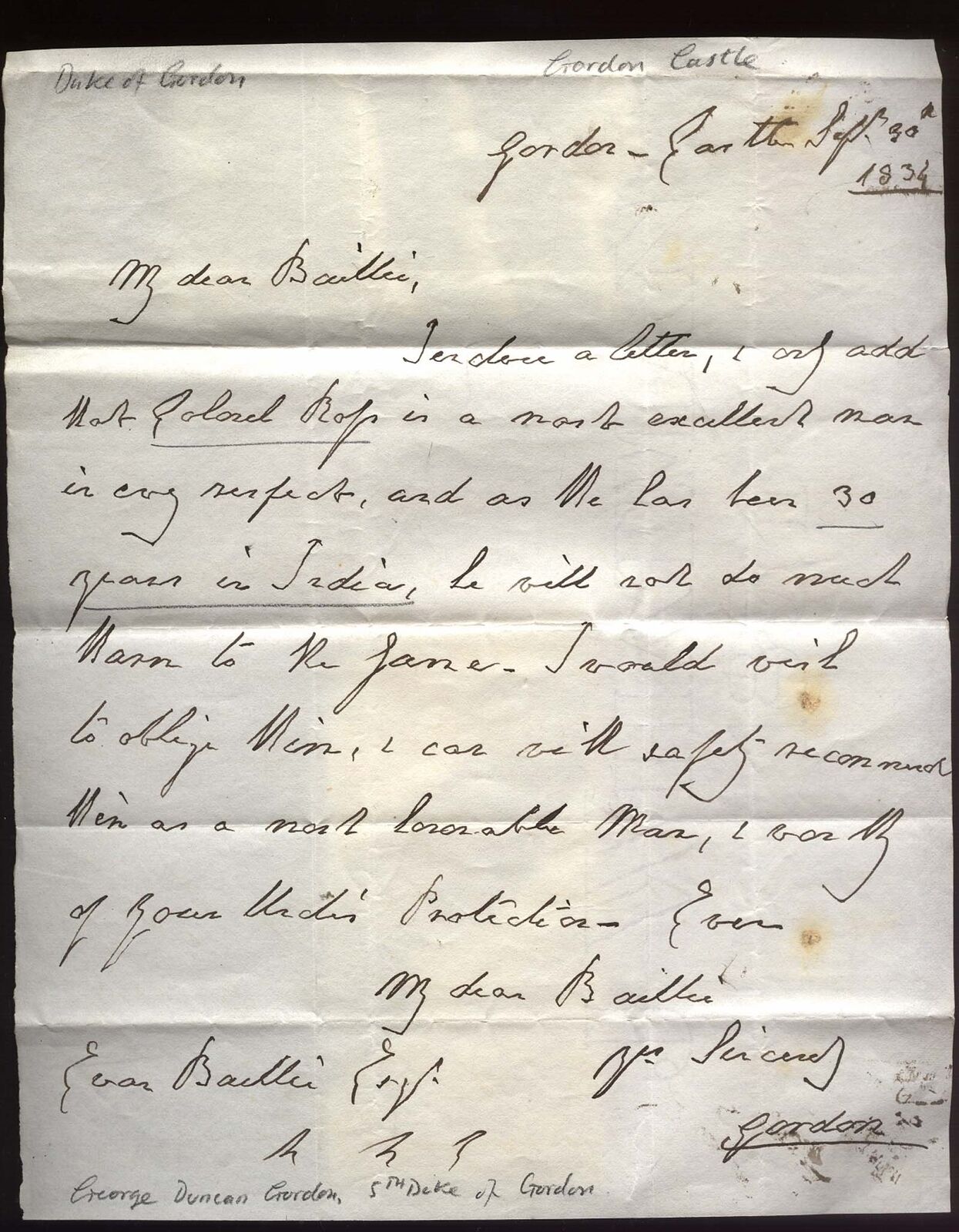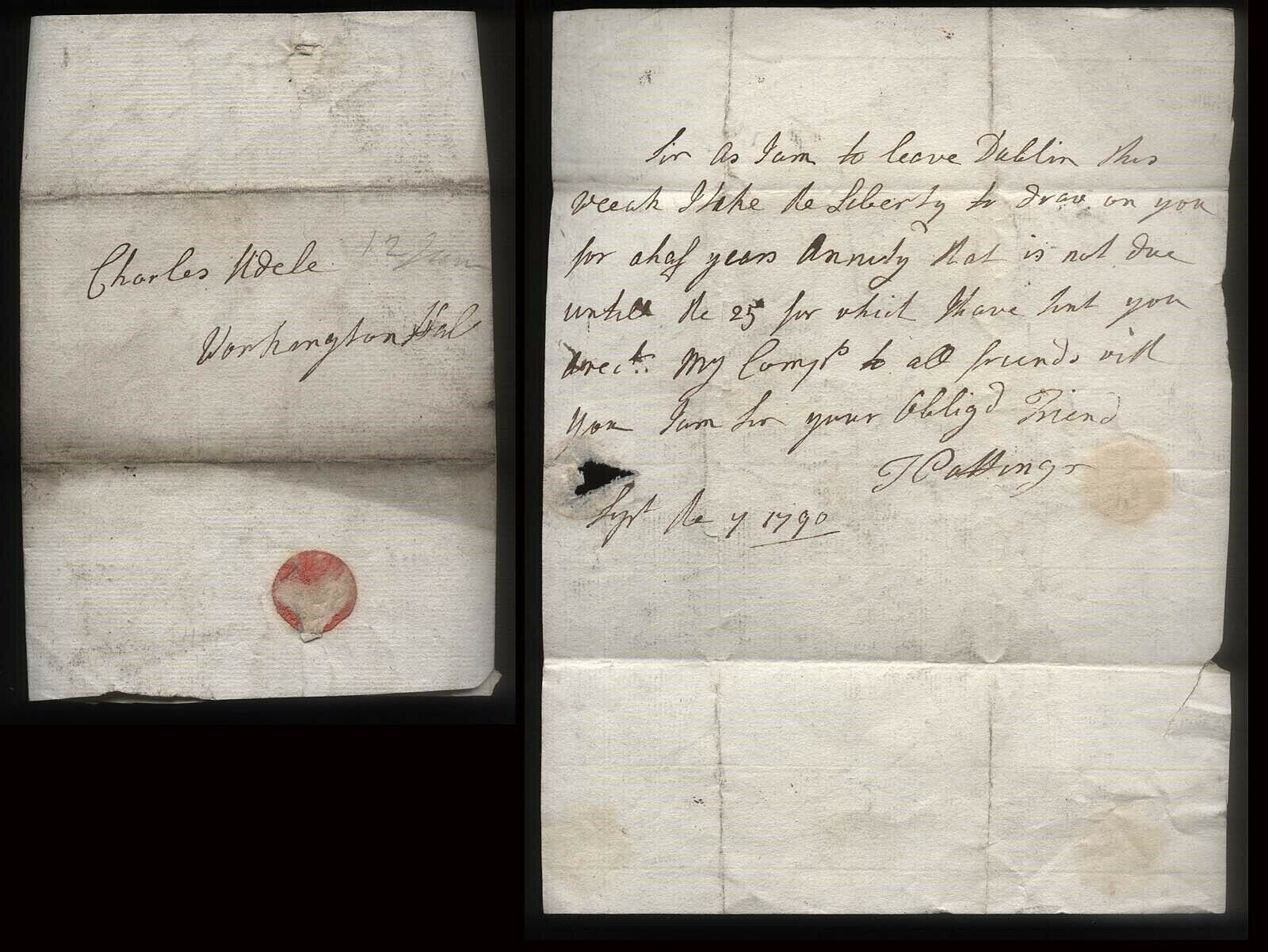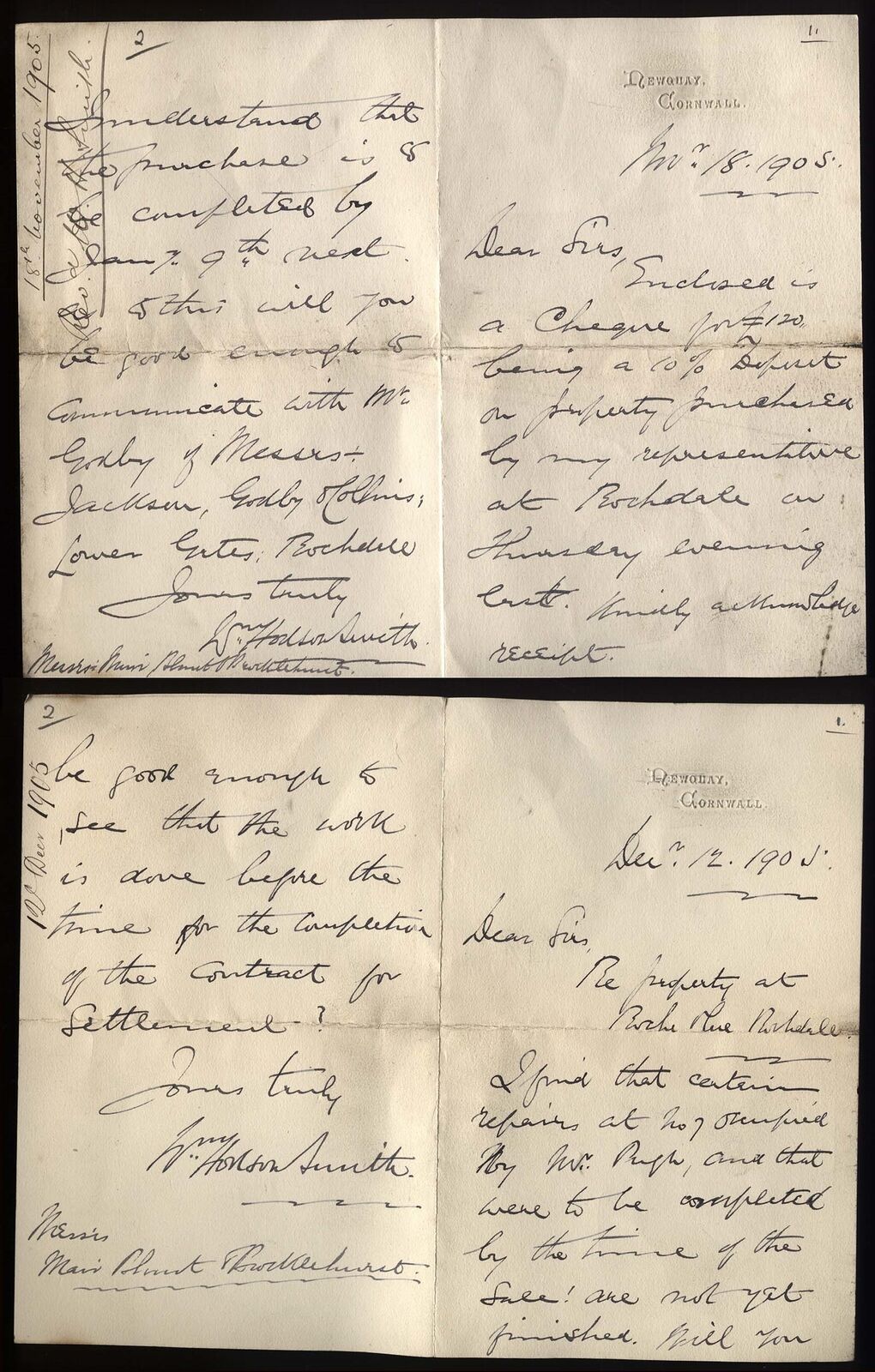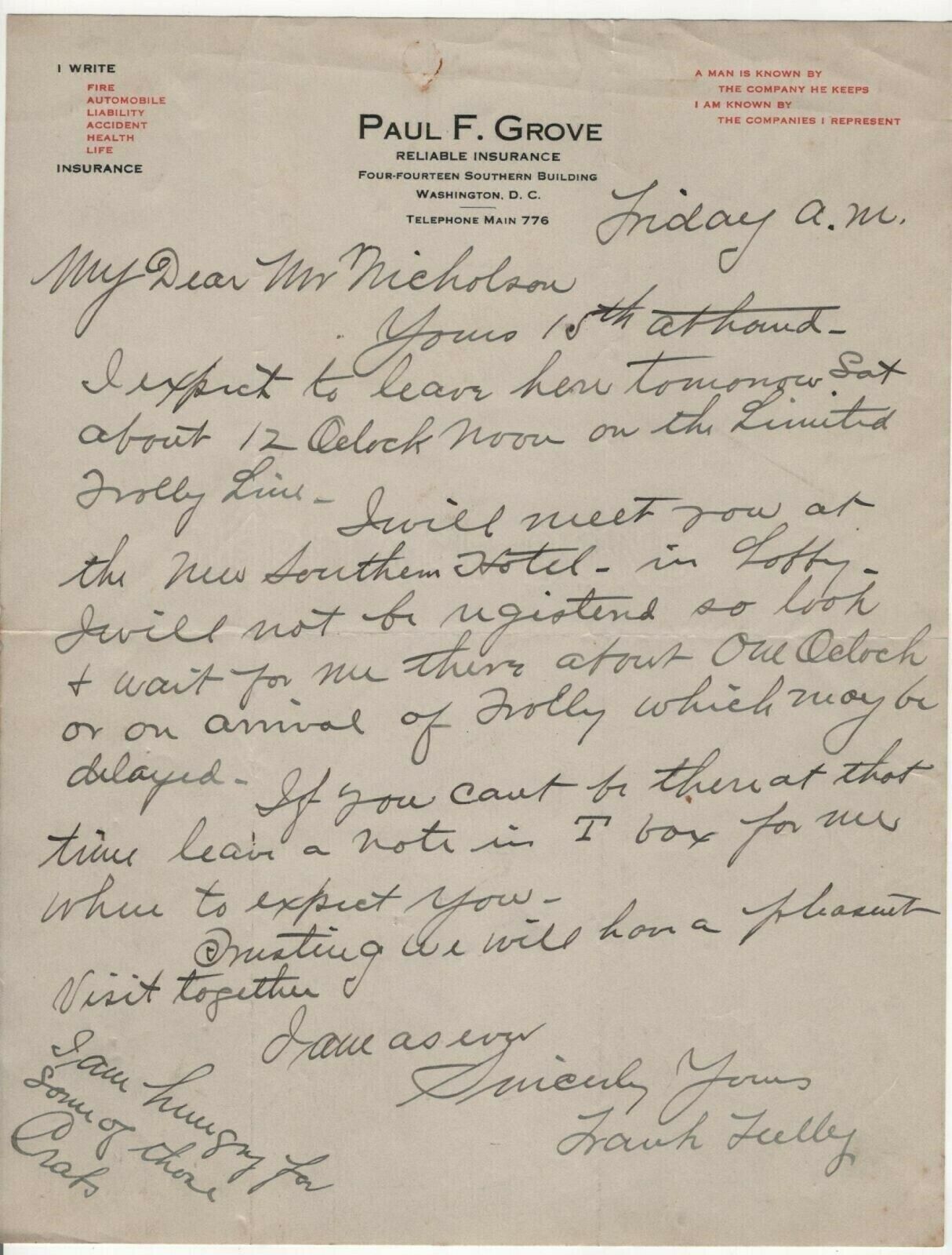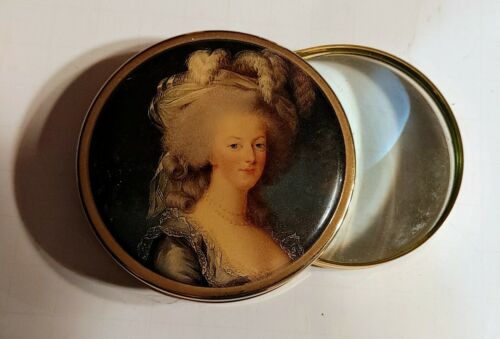-40%
1897 PARIS letter Lady Gertrude Francis Blount to General Sir Martin Dillon
$ 51.18
- Description
- Size Guide
Description
1897 PARIS letter Lady Gertrude Francis Blount to General Sir Martin DillonThis product data sheet is originally written in English.
1897
PARIS
and dated Feb 4th, A Fine letter Lady Gertrude Francis
Blount
to General Sir Martin Dillon from their Home at 59 Rue de
Courcelles
, Mentioning Lady
Germiston
died in 1891 and that she is the only one left of her generation living, and she is the only Grandchild of Lady
Jerningham
, mentions the Archbishop of Narbonne, she's reading Lord Roberts "Forty years in India", mentions Edward Aston Charles
Blount
marrying Clara de
Bassano
, daughter of
Napoléon
Hugues
Charles Marie
Ghislain
Maret
de
Bassano
,
Duc
de
Bassano
and mentions her husband Sir Edward. (Lady
Blount
died in November the same year).
Sir Edward Charles
Blount
KCB
Shortly after Edward
Blount's
sixty-eighth birthday celebration at his Paris home,
59 Rue de
Courcelles
, an agreement was made with Dr T F Campbell to lease (with option to purchase)
Imberhorne
House, park and woodland, now increased to 100 acres.
The banker and promoter of French Railways, was born on 14th March 1809 at the family seat
Bellamour
near
Rugeley
, Staffordshire, the second son of Mr Edward
Blount
(1769-1843) by his wife Frances, daughter of Francis
Wright
of
Fitzwalters
, Essex. In spite of the Catholic fervour of the family, Edward was sent to
Rugeley
Grammar School, whilst gaining useful knowledge of French from an émigré priest. He completed his studies at St Mary
?
s College,
Oscott
, near Birmingham, a Catholic seat of learning founded in 1794. Among his many college friends were the Jerningham brothers of his future wife.
After a short experience of commercial life in the London office of the Provincial Bank of Ireland, he entered the Home Office. In the autumn of 1829, he was appointed Honorary Attaché to the British Embassy, Paris, later transferring to the British Consulate at the Vatican in Rome. In 1831 he joined the Paris banking firm of Callagan et Cie but with his father?s help started the bank of Edward Blount, Père et Fils in Rue Laffitte. The venture proved so successful, that he was invited by the French banker Charles Laffitte to form a new merchant bank, Laffitte, Blount et Cie in Rue Basse du Rempart, Paris.
On the 18th November 1834, Edward Blount married the beautiful Gertrude Frances Jerningham, third daughter of the Hon William Jerningham, brother to Lord Stafford, at St Mary?s Roman Catholic Church, Shifnal in Shropshire. She bore him two sons and three daughters during almost sixty-three years of a happy union.
In 1838 the French government?s attempt to construct railway trunk lines under the control of the state was defeated, thereby allowing the projects open to private enterprise. Edward Blount, who had contributed several articles on the subject in The Railway Chronicle, offered, through his bank shareholders, to finance construction of a twelve-mile track from Paris to St. Germain-en-Laye. It was accepted. Following the opening in July 1840, and flush with its success, Edward Blount offered to finance a line from Paris to Rouen. His bank would raise two-thirds of the cost through English and French investors, on the French government?s undertaking to provide the remaining third. It was approved, and the Chemin de fer de l?Ouest Compagnie was formed by Edward Blount who became chairman.
To gain knowledge of railway management and experience in engine driving, Edward Blount spent four months with the London & North Western Railway Company. Consequently on his return he often drove a train from Paris to his home at St. Germain-en-Laye. He also arranged for fifty British drivers to work for the French company, which prospered from the first.
In 1845, with Edward Blount?s financial backing, the line from Amiens to Boulogne and, in 1853, the lines from Lyons to Avignon and between Lyons, Macon and Geneva were constructed. During the period of funding the railway trunk lines, Edward Blount financially assisted King Louis Philippe to escape to England on the outbreak of the 1848 Revolution. This act may have led to the failure of the bank, though all the creditors were eventually paid in full.
In 1852, aided by several wealthy friends, including Thomas Brassey a leading railway builder and the financiers George Carr-Glyn and Anthony de Rothschild, he started a new merchant banking business under the style Edward Blount et Cie in Rue de la Paix, Paris. The venture soon prospered, and Edward Blount was invited to act as banker to the Papal government.
After the war of Italian Independence (1859) and the annexation of the Papal States to the new kingdom of Italy, he had the delicate task of arranging the transfer of all financial funds. At the outbreak of the Franco-Prussian War, and capitulation of Napoleon III at Sedan (September 1870), Edward Blount suspended his bank?s business and transferred it to the Societe Generale of Paris, of which he became President. When the Prussians threatened to besiege Paris, and all the British Embassy officials had decamped to Tours, Edward Blount took charge of British Interests, being on 24th January 1871, formally appointed Acting British Consul.
During the siege he distributed money and food to large numbers of starving English poor. Consequently for his services at the Embassy he was made a Commander of the Bath (CB) by Her majesty Queen Victoria on 14th March 1871. Lord Malmesbury, speaking of him in the House of Lords, said, ?his name would be considered noble as long as the history of the siege is recorded?.
In view of banking and railway interests, Edward Blount made frequent visits to London from his new Paris home, 59 Rue de Courcelles.
Devoted to the turf he had an interest in the racing stables of the Comte de Lagrange, on whose death he kept a small stable of his own. He was a member of the French Jockey Club and a reputed ?good whip?. A small racehorse breeding stable was later started at Imberhorne using Normandy mares and English stallions.
It was during one of Edward Blount?s frequent visits to London, that he was invited by Sir Joseph Montefiore to his new house, Worth Park, near Crawley, [later becoming Milton Mount College for the daughters of Congregational Ministers, at Pound Hill]. There he met the ebullient and wealthy the Hon Mrs Fanny Charlotte Montgomery of The Elms, on the Horsham side of Crawley, later known as Buckswood Grange. Mrs Montgomery was the daughter of Baron Leconfield and grand daughter of the Rev William Blunt of Crabbett Park, and an ardent Roman Catholic. Having mentioned he was seeking to obtain a permanent residence in England, preferably near Newhaven, Mrs Montgomery promised to inform Edward Blount should a suitable property come on the market. It was several weeks later at his lodgings in Tokenhouse Yard, London, that Edward Blount received a telegram from Mrs Montgomery informing him of a ?bijou residence? set in its own parkland, ?Imberhorne? near East Grinstead.
Imberhorne comprised a two-storeyed house with jettied gables, rough stone facade, stone mullioned and transomed Windows, with wooden dormers in the attic projecting from both sides of the double-pitched slated roofs. Nearby was a coach-house and stable to accommodate three carriages and four horses. The grounds comprised lawns and shrubberies, a conservatory with forcing greenhouses and a gardener?s cottage.
Immediately delighted with the house, Edward Blount arranged a contract through his London bank solicitors. According to Miss Marguerite Blount in a later interview, ?not only did my great-grandfather admire the house and its surround, but he liked the railway at the bottom of the so-called lawn and bought without telling my great grandmother. When she arrived to visit she burst into tears because it had no garden?. Although Imberhorne House [later renamed Imberhorne Manor] with its 100 acres of parkland was on an initial one year lease, it was Henry (Edward Blount?s younger son) who proposed, in October 1877, that they should take up the option to purchase. Henry Blount also supported the London bank?s proposition that Imberhorne Farm and land (largely self-supporting) should also be acquired following Dr Campbell?s intimation that he was willing to sell.
By January 1878, having purchased the Imberhorne estate, Edward Blount allowed Henry to supervise the modifications to the house and the farm?s future programme and workforce with the newly appointed bailiff. Within a few weeks, and at the request of their French chef, a larger kitchen and pantry was created at the expense of a reception room. At the west-end of the house, a room designed as a studio was converted into a private chapel, to which the local Catholic devout were invited. [Further details later]
A decade later the house underwent considerable structural changes. The east end was extended to provide larger dining, drawing and reception rooms, with a SPORTS den and library on the ground floor. At the entrance, a magnificent staircase, ?golden beneath the light from a vast chandelier?, led to the bedrooms, bathrooms, dressing rooms and a nursery (later schoolroom). In the attic above was bed-sit accommodation for the staff, butler, chef/cook, housekeeper, nursemaid/governess and lady?s maid. Finally to accommodate the increasing number of Catholic worshippers the chapel was considerably enlarged. The house also had an enormous cellar for the storage of logs, wine etc, and several years later a coke boiler was installed to provide a ?not-too-successful? central heating system.
From 1878 it was customary for the Blount?s, with a handful of French ?domestiques?, to take up residence for between six and eight weeks, thrice a year. The remaining weeks were either spent in Paris or, during the high season, at Biarritz.
On June 15th 1888, it was reported in the London Gazette, that Her majesty Queen Victoria was pleased to give Orders?. ?for Edward Blount CB to be conferred a Knight Commander of the Most Honourable Order of the Bath?. It was later reported that if Queen Victoria ?had her way?, she would have raised him to the Peerage.
Congratulations were received from leading persons, companies and organisations. Including an illuminated address from the chief inhabitants of East Grinstead:-
?We, the undersigned, representing the trades and inhabitants generally of East Grinstead, beg to offer you our sincere and hearty congratulations on the distinguished honour conferred upon you by Her majesty the Queen? in recognition of your work as President of the British Chamber of Commerce and Member of the French Chamber?
Honours had in fact been showered upon him from all sides. In addition to his English Knighthood, he was a Chevalier of the Legion d?Honneur and Commander of the Orders of Pius IX, of Isabella of Spain and the Crown of Italy. He was also awarded with the Grand Cross of Osmanii, Turkey. In 1889, the London, Brighton & South Coast Railway acknowledged the considerable contribution he had made to the French Railways by naming one of their new class of locomotives, ?Edward Blount?.
With a steady increase in passenger services, locomotives were required to be heavier and run at higher speeds. ?No.189? with its 6½ft/2m diameter driving wheels, was sent to the Paris Exposition, gaining a Gold Medal. It remained in France for trials on the Paris-Mediterranean line. After several weeks of successful runs, a celebration dinner for Directors and Superintendents was held at Sir Edward Blount?s house in Paris.
In 1894, a popular agitation condemned control by a foreigner of the French Railways as a military peril. Sir Edward Blount, with good grace, resigned as Chairman of the Chemin de fer de l?Ouest Compagnie. The French government however, handsomely acknowledged his services and his fellow directors elected him Honorary President. A few years later, and in view of his advanced age, he also resigned from the Presidency of his banking concern, Societe Generale of Paris. However, fellow directors enthusiastically and unanimously agreed to elect him an Honorary Life President.
Sir Edward and Lady Blount long maintained their position in both English and French high society by frequently entertaining bankers, embassy officials, minor royalty, aristocrats and politicians to many excellent dinners provided by their French chef. However, they did not neglect their Imberhorne staff and farm workers. Consequently for many years about fifty employees and their ladies were invited to play an annual game of cricket, in which ?bachelors? were matched against ?benedicts?. After the match, the whole party adjourned to partake of a splendid dinner served in the commodious coach-house. The event concluded with the bailiff, acting as chairman, proposing the good health of their generous employer and his family.
During his long residence in France, Sir Edward patronised many Catholic institutions and materially aided the Passionist Fathers to establish their mission in the French capital. Consequently having acquired an estate in England and being a staunch adherent of the Catholic faith, he naturally fully supported his wife?s enthusiasm to establish a permanent church and school in East Grinstead. Likewise, he also established a school at Handsworth near Birmingham, where his sister Laura was a Sister of Mercy. He also gave financial support to the Franciscan Presbytery (St Francis and St Anthony) at Crawley, and made arrangements for a grim imposing part-sunken twelve-space family vault to be constructed in the burial ground alongside the church.
Sir Edward and Lady Blount also took a keen interest in several East Grinstead activities and were generous subscribers to many charitable causes. He was elected Chairman of the first constituted committee of the 1888 Cottage Hospital Scheme, thereby establishing the family?s connection with the East Grinstead Queen Victoria Hospital which lasted over sixty years. He was also President of the North End and East Grinstead Cottage Garden and Allotment Association, and as Chairman of the Trustees, opened the new Queens Hall, Queens Road in July 1899, after a great deal of controversy.
Until his late eighties, Sir Edward remained physically active, walking daily (weather permitting) through his estate. As a railway enthusiast (he held a variety of badges allowing free passage on many systems) his routine often led to watching the trains crossing the Copyhold/Imberhorne Viaduct. Nor was it uncommon to see him driving one of his monogrammed carriages around the tortuous roads of East Grinstead. When the Duke of Norfolk (PG) came to officially open the new East Grinstead Post Office in September 1896, Sir Edward, a member of the welcoming committee, offered the Duke full use of his latest landau.
The same year, opportunity arose to purchase the freeholds of the adjoining farms, Gullege, Tilkhurst and Hill Place. Sir Edward now owned over 1000 acres of arable, pasture and woodland. Henry, who had supervised the Imberhorne estate for twenty years, proposed that responsibility of all the farms should within two to three years devolve to his only son, Edward Charles Blount.
Meanwhile, Sir Edward spent most evenings reading in his well-stocked library. He was still of active mind when he began dictating his memoirs and interesting recollections, to a near neighbour Dr Stuart J Reid, who published them in 1902/3. Sir Edward died at Imberhorne, after a short illness, on 15th March 1905, aged ninety-six. Details of his death were reported in all the London and Paris newspapers, and letters and telegrams conveying messages of sympathy arrived in great numbers, among them one from His majesty King Edward VII.
Over 600 mourners attended his funeral, which overflowed outside the Roman Catholic Church of Our Lady and St Peter in London Road. Over fifty estate employees followed the cortege from the chapel at Imberhorne to the church. The church and the subsequent burial service at the family vault in Crawley, was conducted by Dr Amigo, Bishop of Southwark.
Two paintings of Sir Edward Blount, one by Ricart of Paris (c.1855) and the other by J A Vintner (1866), survive.
Lady Gertrude Frances Blount
Gertrude Frances Blount née Jerningham, was born on 6th July 1811, at the family home near Tong, Shropshire, and was baptised into the Catholic faith in the private chapel of Shifnal Manor. At the age of twenty-three, she married Edward Blount, whom she had known from childhood. She bore him five children, two sons and three daughters, and throughout her life in France, took a deep interest in the religious French Order of Dominicans, founded in the 13th century
Her eldest son, Herbert Aston (1837-78) was one of the French delegates who attended the 1863 conference ?for the amelioration of the condition of the wounded of the armies in the field?, namely the Red Cross Organisation. As a consequence he became a Chevalier of the Movement, and assisted the wounded at the battle of Sedan in September 1870.
When the Prussians threatened to besiege Paris, Edward Blount arranged for his wife to go initially to Villandry, near Tours, but later to her brother?s house in Shropshire.
During the siege and commune uprising in Paris, she received several letters from Edward, including one by balloon!
Jan 1871? ?all the British official?s have left Paris??Colonel Claremont has placed me Acting Consul of the Embassy?
Feb 1871??have married Richard Wallace (Lord Hertford?s base-born) to the Parisian mother of his many illegitimate children?
March 1871??misery around me is appalling??have killed my remaining cow, but a little starvation does no harm??
Following the acquisition of Imberhorne and the establishment of a Catholic chapel dedicated to St Edward and St Louis at the western end of the house, Lady Blount took an active interest in the people of East Grinstead, especially the Catholic community. Consequently through her efforts an improvised school for Catholic children was started in an attic room at Imberhorne Farmhouse. Later a permanent school, Imberhorne School, now known as St Peter?s, was built between the house and the town at Sir Edward?s expense. Finally, through Lady Blount?s enthusiasm to have a Catholic Church, other than their own chapel, they bought a suitable site on the London Road. Dedicated to Our Lady and St Peter, the church was constructed at the expense of Lady Blount, who sadly did not live to see its completion.
In November 1884, Edward and Gertrude Blount celebrated their golden wedding and, with their names associated with so many works of Catholic benevolence, received hundreds of felicitations and good wishes. The Holy Father sent his Benediction and both Queen Victoria and Prince Edward, their warmest congratulations.
After an illness stretching into several weeks, Lady Blount died at Imberhorne on the 9th November 1897, aged eighty-six. Telegraphs of sincere condolences were received from Edward, Prince of Wales, the Empress Eugenie and the Duke and Duchess of Orleans, to all of whom Lady Blount was intimately known.
She was dressed in the habit as a Member of the Dominican Order and watched over by several Dominican nuns in the private chapel at Imberhorne. The funeral service at the Franciscan Friary at Crawley was conducted by Fr Lawrence before burial in the family vault.
:
Powered by SixBit's eCommerce Solution
1897 PARIS and dated Feb 4th, A Fine letter Lady Gertrude Francis Blount to General Sir Martin Dillon from their Home at 59 Rue de Courcelles, Mentioning Lady Germiston died in 1891 and that she is the only one left of her generation living, and she is the only Grandchild of Lady Jerningham, mentions the Archbishop of Narbonne, she's reading Lord Roberts "Forty years in India", mentions Edward Aston Charles Blount marrying Clara de Bassano, daughter of Napoléon Hugues Charles Marie Ghislain Maret de Bassano, Duc de Bassano and mentions her husband Sir Edward. (Lady Blount died in November the same year). Sir Edward Charles Blount KCB Shortly after Edward Blount's sixty-eighth birthday celebration at his Paris home, 59 Rue de Courcelles, an agreement was made with Dr T F Campbell to lease
Related Interests
Jerningham family
EAN
Does Not apply
Country
France
Family Surname
Blount
City/Town/Village/Place
Paris
Street Location
59 Rue de Courcelles
Era
1891-1900
Addressed to
General Sir Martin Dillon
Document Type
Manuscript Letter
Year of Issue
1897
Titled Families
Sir Edward Blount

